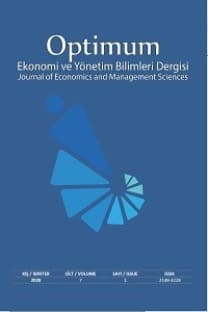Forklift Alternatiflerinin KEMIRA-M Yöntemi ile Değerlendirilmesi
İşletmelerde, insan gücünün yetmediği ağır yüklerin
kaldırılması, istenilen yerlere götürülmesi ve uygun yerlere istiflenmesi için
genellikle forkliftler kullanılmaktadır. Depoların aktif kullanımının
sağlanması için depoların fiziki şartlarına uygun forkliftin seçilmesi
önemlidir. Bu çalışmada bir tekstil işletmesinde depolamada kullanılacak
forklift alternatiflerinin değerlendirilerek işletme açısından en uygun olan
forkliftin belirlenmesinde yeni bir Çok Kriterli Karar Verme (ÇKKV) yöntemi
olan KEMIRA-M (KEmeny Median Indicator Rank Accordance-Modified) yöntemi
kullanılmıştır. Bu yöntem çok fazla başlangıç bilgisi gerektirmemekte, bu
açıdan kriterlerin ağırlıklarını belirlemede ve en uygun alternatifin seçiminde
kullanılabilmektedir. Çalışmanın sonucunda tekstil işletmesinin ihtiyaçlarını
en iyi karşılayacak forklift alternatifi KEMIRA-M yöntemi ile belirlenerek
işletmeye karar alma sürecinde yardımcı olunmuştur.
Anahtar Kelimeler:
Çok Kriterli Karar Verme (ÇKKV), KEMIRA-M Yöntemi, Forklift Seçimi
Evaluation of Forklift Alternatives with KEMIRA-M Method
Businesses generally
uses forklifts for lifting, stacking and transporting to the desired location
of heavy loads in case of human power is not enough. It is important to select
suitable forklifts for the physical conditions of the warehouses in order to
ensure the active use of them. In storage, the selection of the appropriate
forklift for physical conditions of the warehouse is important to use
warehouses effectively. In this study, KEMIRA-M (KEmeny Median Indicator Rank
Accordance-Modified) method, which is a new Multi-Criteria Decision Making (MCDM)
method, was used to evaluate forklift alternatives to be used in storage and to
determine the most appropriate forklift for the textile company. This method
does not require much initial information, so it can be used to determine the
weights of the criteria and to select the most appropriate alternative. As a
result of the study, forklift alternative that will best meet the needs of the
textile company was determined with KEMIRA-M method, by this way the company
has been aided during the decision process.
___
- Atanasković, P., Gajić, V., Dadić, I. & Nikoličić, S., (2013). Selection of Forklift Unit for Warehouse Operation by Applying Multi-Criteria Analysis, Promet – Traffic&Transportation, 25(4), 379-386.
- Hassan, M.M.D. (2010). A Framework for Selection of Material Handling Equipment in Manufacturing and Logistics Facilities, Journal of Manufacturing Technology Management, 21(2), 246 – 268.
- Jahan, A., Edwards, K. L. & Bahraminasab, M. (2016), Multi-Criteria Decision Analysis for Supporting the Selection of Engineering Materials in Product Design, Second Edition, Butterworth-Heinemann
- Kosareva, N. Zavadskas , E. K., Krylovas, A. & Dadelo, S. (2016). Personnel Ranking and Selection Problem Solution by Application of KEMIRA Method. International Journal of Computers Communications & Control, 11(1), 51-66.
- Krylovas, A., Zavadskas, E. K. & Kosareva, N. (2016). Multiple Criteria Decision-Making KEMIRA-M Method for Solution of Location Alternatives, Economic Research-Ekonomska Istraživanja, 29(1), 50-65.
- Krylovas, A., Zavadskas, E. K., Kosareva, N. & Dadelo, S. (2014). New KEMIRA Method for Determining Criteria Priority and Weights in Solving MCDM Problem. International Journal of Information Technology & Decision Making, 13, 1119–1133.
- Kulak, O. (2005). A Decision Support System for Fuzzy Multi-Attribute Selection of Material Handling Equipments, Expert Systems with Applications, 29, 310–319.
- Onut, S., Soner Kara S. & Mert, S. (2009). Selecting the Suitable Material Handling Equipment in the Presence of Vagueness, International Journal of Advenced Manufacturing Technology, 44, 818–828.
- Pamučar, D. & Ćirović, G. (2015). The Selection of Transport and Handling Resources in Logistics Centers Using Multi-Attributive Border Approximation Area Comparison (MABAC), Expert Systems with Applications, 42(6), 3016-3028.
- Park,Y.B. (1996). ICMESE: Intelligent Consultant System for Material Handling Equipment Selection and Evaluation, Journal of Manufacturing Systems,15(5), 325-333.
- Yaman, R. (2001). A Knowledge-Based Approach for Selection of Material Handling Equipment and Material Handling System Pre-design, Turkish Journal of Engineering and Environmental Sciences, 25, 267- 278.
- Yayın Aralığı: Yılda 2 Sayı
- Başlangıç: 2014
- Yayıncı: -
Sayıdaki Diğer Makaleler
Siyasal ve Hukuksalın Fenomenolojisinin Eleştirisi
Kamu Harcamaları ve Ekonomik Büyüme Arasındaki İlişki: Kırgızistan Örneği
Raziye ABDIYEVA, Hakan ÇETİNTAŞ
Belirsizlik Altında Üretim Planlaması Problemi için Robust Eniyileme Modeli
Forklift Alternatiflerinin KEMIRA-M Yöntemi ile Değerlendirilmesi
